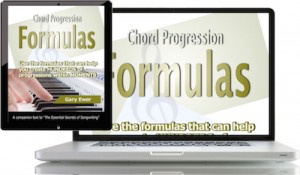How much thought do you give to the instrumental accompaniment for your songs? The question may feel like a no-brainer; if you’re a guitarist, you’ll use guitar. If you’re a keyboardist, you’ll lean towards using keyboards.
But simply deciding to use the instrument you’re most comfortable with may be missing great opportunities to create something interesting for your audience.
 “Chord Progression Formulas” shows you a system for creating your own progressions in seconds using some basic formulas, in both major or minor keys. It’s available at the Online Store.
“Chord Progression Formulas” shows you a system for creating your own progressions in seconds using some basic formulas, in both major or minor keys. It’s available at the Online Store.
In the classical music world, where writing for orchestra is common, the choice of any one instrument at any one time is a crucial part of the musical challenge. The danger of not carefully considering instrumentation is that all of your songs will start to get a sameness about them.
 For some of pop music’s greatest acts, interesting instrumentation has been a key part of their success. Cello, theremin, harpsichord, flute, organ and other non-standard instruments — each instrument adds to the thorough palette of sounds at a band’s disposal, and can play a crucial role in generating listener interest.
For some of pop music’s greatest acts, interesting instrumentation has been a key part of their success. Cello, theremin, harpsichord, flute, organ and other non-standard instruments — each instrument adds to the thorough palette of sounds at a band’s disposal, and can play a crucial role in generating listener interest.
If you’re looking to expand on the instruments you use in your recordings, consider the following tips:
- Use authentic (rather than synthesized) where possible. It’s true that technology can synthesize instrumental sounds that are astonishingly real. But having an actual person playing the instrument gives us a sense of realism that’s much harder to synthesize, and gives us a more true to-life sound.
- Try to come up with a written part. If writing a part out isn’t within your abilities, play what you want onto a recording device, and try to enlist the help of a music student at a local college or university to transcribe what you’ve written. Using instrumentalists usually means that you’ll need to give a written part to them.
- Take advice from players. Leaping from a low G to a high G may be a piece of cake on a violin, but difficult to do with ease on a trumpet. Every instrument has their idiosyncrasies, and players of those instruments can help you adjust a part to make it more idiomatic.
- Think about your live performances. You may have a local bagpipe player who can do a recording session for you. But what about your live performances? You’ll need options for your song, because you won’t necessarily have that player with you for every concert. This may be where a good synth version of your added instrument will suffice, and hopefully a bagpipe setting will work fine.
- Have musical reasons for your instrumental choices. Many of the choices you might make will sound unique, but uniqueness is not always the best motivation for using particular instruments. Think about your song, and the feeling you want to convey. A small string grouping will work really well in one particular song, but may add nothing to another.
Having said all this, remember that most of the time listeners like a certain amount of consistency with instrumentation. If every song on your next album uses a completely different instrumentation, that can make it difficult for the listeners to identify any kind of consistent sound with relation to your music.
The best approach is to record your song with a bare instrumentation — guitar, bass and drums for example — and then decide what can be added to that sound, rather than thinking of each song as an entirely blank slate.
 Written by Gary Ewer. Follow Gary on Twitter
Written by Gary Ewer. Follow Gary on Twitter
 It’s time to declutter your songwriting process. “The Essential Secrets of Songwriting” eBook Bundle packages can help you become a more efficient, prolific songwriter. Get today’s 10-eBook Deluxe Bundle deal: a free copy of “Creative Chord Progressions”
It’s time to declutter your songwriting process. “The Essential Secrets of Songwriting” eBook Bundle packages can help you become a more efficient, prolific songwriter. Get today’s 10-eBook Deluxe Bundle deal: a free copy of “Creative Chord Progressions”










